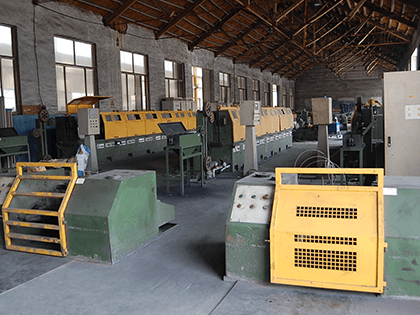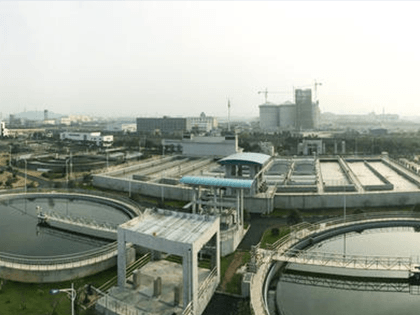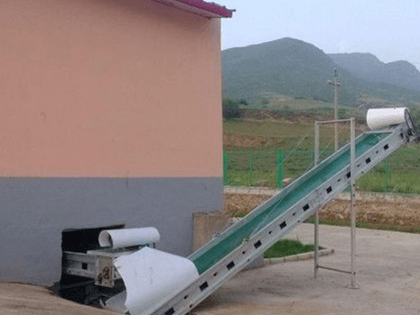Hidden danger may be brought by sludge composting
Author: Taida machine Release time:2016-08-19
Reading guidance:Municipal waste water treatment plant sludge is rich in nitrogen, phosphorus, potassium and organic matter and so on, which is good for plant growth. Therefore, the land use of sludge is a kind of slud
Municipal waste water treatment plant sludge is rich in nitrogen, phosphorus, potassium and organic matter and so on, which is good for plant growth. Therefore, the land use of sludge is a kind of sludge disposal method which is suitable for our country.
But at the same time, sludge also inevitably containing harmful substances such as pathogens and heavy metals, there is the possibility of secondary pollution. The composting treatment, can effectively kill the pathogenic bacteria and parasite eggs, but does not remove the heavy metals in sewage sludge. Therefore, sludge compost in the process of heavy metal is easy to in the soil and as accumulation in the body, thus becoming the main limiting factor for the land use.
1. Sludge composting will bring influence to the heavy metal content of soil
Content of heavy metals in sludge compost is several times to several times of the soil background value, after applied into farmland, significantly increased the contents of heavy metals in soil, may cause heavy metal pollution of soil. Therefore, the state on the concentration of heavy metals in sewage sludge have strict limits.
Generally speaking, with the increase in the amount of sludge applied, the content of heavy metals in soil basic presentation increasing trend, with the increase of sludge compost ratio, mixed soil Zn and Cu mass fraction were increased 8.43% to 94.5%, 16.5% to 97.7%; mass fraction of Pb from below the Pb detection limit value can be obviously detected; mass fraction of Ni no significant change; Cr mass fraction decreased 4.63% to 10.5%; CD mass fraction due to lower than CD detection limits are not detected. When the sludge compost stem re application ratio of 20%, the content of heavy metals are far below the standard of soil environmental quality of China (to ensure agricultural production, maintain human health soil limit).
Distribution of heavy metal Zn in various forms has a certain percentage, which Zn efficient state (exchangeable and carbonate bound) accounted for 16.8% of the total mass of Zn, and 99% of the total mass of Cu is in a non exchange state (organic combination state and residual state) exists in the form. Thus, sludge compost soil use should pay special attention to the adverse effects of Zn which may be caused to the environment.
2. Sludge composting brings influence to nitrogen and phosphorus absorption of festuca arundinacea and marigold.
After composting treatment of sludge containing rich organic matter and nitrogen, phosphorus and other nutrient elements of plant, inevitably containing heavy metals and refractory organic toxicants. Sludge compost into the soil, due to nutrient and heavy metal content in soil were increased greatly, will to the plant to produce beneficial or detrimental effects of growth.
In the sludge compost in land use, only the sludge compost ratio control in a certain range, in order to maximize its advantages to promote plant growth, reduce its negative effects. For tall fescue, when the sludge compost ratio in the range of 0~10%, the seed germination rate of more than 90%, raising the plant height and stem heavy with sludge compost increased, root length did not change significantly; when the sludge compost ratio is 20%, the seed germination rate of less than 35%, the dry weight decreased significantly, the whole plant. The thin slender marigold, when the sludge heap fertilizer proportion is 5%, the seed germination rate, plant height, root the length and dry weight reached the maximum; continue to increase sludge compost, the growth index decreased gradually, and sludge compost proportion is 20%, the seed has not only bud, observed by transplanting, plant growth has been at this time Very significantly inhibited, showing pathological.
3. Sludge composting brings influence to nitrogen and phosphorus absorption of festuca arundinacea and marigold.
Sludge compost is a good organic fertilizer, to increase soil nitrogen, phosphorus and other nutrients, increase soil organic matter has obvious effect and application of sewage sludge compost can provide a rich source of nitrogen and phosphorus source for plants. When sludge compost ratio from 0 to 10% when, tall fescue of total nitrogen and total phosphorus uptake with the increase of the amount of fertilization application in sludge compost increased to 10% reached the maximum, which with the plant biomass reached the maximum proportion of the same. Marigold of total nitrogen, total phosphorus uptake in sludge compost ratio is 5%, the highest, at the same time, the biomass is also the largest.
4. Sludge composting brings influence to accumulation characteristics of festuca arundinacea and marigold.
Due to different plant uptake and accumulation of heavy metals cause differences: on the one hand, the roots of characteristics is the key to decide the plant absorption of heavy metals; on the other hand, due to the differences in structure and physiological characteristics of different plants, plant uptake of metals from roots to shoots. In this study, the ability of different tall fescue on heavy metals Zn, Cu, Cr set, ability of Ni was higher than that of marigold, the analysis thinks, tall fescue has more developed roots and higher biomass than marigold, it is possible through improving root exudates or change the rhizosphere microflora to activation of some heavy metals in the soil, thereby enhancing the plant root cell membrane specific metal Tran-membrane protein put it into a cell, it will require further validation of the experimental evidence; in addition, plant roots due to heavy metal adsorption, passivation or precipitation to shoot transportation, Tall fescue whether there certain heavy metal transport carrier, can be more heavy metals from roots transported to shoot, is also worthy of further research.
Therefore, in the use of urban sewage sludge compost land use methods to pay attention to the impact of heavy metals on the book and the plant's attention is beyond the standard value, and the need to carry out a large number of experiments to study.
But at the same time, sludge also inevitably containing harmful substances such as pathogens and heavy metals, there is the possibility of secondary pollution. The composting treatment, can effectively kill the pathogenic bacteria and parasite eggs, but does not remove the heavy metals in sewage sludge. Therefore, sludge compost in the process of heavy metal is easy to in the soil and as accumulation in the body, thus becoming the main limiting factor for the land use.
1. Sludge composting will bring influence to the heavy metal content of soil
Content of heavy metals in sludge compost is several times to several times of the soil background value, after applied into farmland, significantly increased the contents of heavy metals in soil, may cause heavy metal pollution of soil. Therefore, the state on the concentration of heavy metals in sewage sludge have strict limits.
Generally speaking, with the increase in the amount of sludge applied, the content of heavy metals in soil basic presentation increasing trend, with the increase of sludge compost ratio, mixed soil Zn and Cu mass fraction were increased 8.43% to 94.5%, 16.5% to 97.7%; mass fraction of Pb from below the Pb detection limit value can be obviously detected; mass fraction of Ni no significant change; Cr mass fraction decreased 4.63% to 10.5%; CD mass fraction due to lower than CD detection limits are not detected. When the sludge compost stem re application ratio of 20%, the content of heavy metals are far below the standard of soil environmental quality of China (to ensure agricultural production, maintain human health soil limit).
Distribution of heavy metal Zn in various forms has a certain percentage, which Zn efficient state (exchangeable and carbonate bound) accounted for 16.8% of the total mass of Zn, and 99% of the total mass of Cu is in a non exchange state (organic combination state and residual state) exists in the form. Thus, sludge compost soil use should pay special attention to the adverse effects of Zn which may be caused to the environment.
2. Sludge composting brings influence to nitrogen and phosphorus absorption of festuca arundinacea and marigold.
After composting treatment of sludge containing rich organic matter and nitrogen, phosphorus and other nutrient elements of plant, inevitably containing heavy metals and refractory organic toxicants. Sludge compost into the soil, due to nutrient and heavy metal content in soil were increased greatly, will to the plant to produce beneficial or detrimental effects of growth.
In the sludge compost in land use, only the sludge compost ratio control in a certain range, in order to maximize its advantages to promote plant growth, reduce its negative effects. For tall fescue, when the sludge compost ratio in the range of 0~10%, the seed germination rate of more than 90%, raising the plant height and stem heavy with sludge compost increased, root length did not change significantly; when the sludge compost ratio is 20%, the seed germination rate of less than 35%, the dry weight decreased significantly, the whole plant. The thin slender marigold, when the sludge heap fertilizer proportion is 5%, the seed germination rate, plant height, root the length and dry weight reached the maximum; continue to increase sludge compost, the growth index decreased gradually, and sludge compost proportion is 20%, the seed has not only bud, observed by transplanting, plant growth has been at this time Very significantly inhibited, showing pathological.
3. Sludge composting brings influence to nitrogen and phosphorus absorption of festuca arundinacea and marigold.
Sludge compost is a good organic fertilizer, to increase soil nitrogen, phosphorus and other nutrients, increase soil organic matter has obvious effect and application of sewage sludge compost can provide a rich source of nitrogen and phosphorus source for plants. When sludge compost ratio from 0 to 10% when, tall fescue of total nitrogen and total phosphorus uptake with the increase of the amount of fertilization application in sludge compost increased to 10% reached the maximum, which with the plant biomass reached the maximum proportion of the same. Marigold of total nitrogen, total phosphorus uptake in sludge compost ratio is 5%, the highest, at the same time, the biomass is also the largest.
4. Sludge composting brings influence to accumulation characteristics of festuca arundinacea and marigold.
Due to different plant uptake and accumulation of heavy metals cause differences: on the one hand, the roots of characteristics is the key to decide the plant absorption of heavy metals; on the other hand, due to the differences in structure and physiological characteristics of different plants, plant uptake of metals from roots to shoots. In this study, the ability of different tall fescue on heavy metals Zn, Cu, Cr set, ability of Ni was higher than that of marigold, the analysis thinks, tall fescue has more developed roots and higher biomass than marigold, it is possible through improving root exudates or change the rhizosphere microflora to activation of some heavy metals in the soil, thereby enhancing the plant root cell membrane specific metal Tran-membrane protein put it into a cell, it will require further validation of the experimental evidence; in addition, plant roots due to heavy metal adsorption, passivation or precipitation to shoot transportation, Tall fescue whether there certain heavy metal transport carrier, can be more heavy metals from roots transported to shoot, is also worthy of further research.
Therefore, in the use of urban sewage sludge compost land use methods to pay attention to the impact of heavy metals on the book and the plant's attention is beyond the standard value, and the need to carry out a large number of experiments to study.
:Whether will sawdust brings benefits to sludge composting :Summary of sludge disposal technology in hospital
Relevant news
- 2016-01-12OSC-II Model Sludge Dryer Deliv
- 2016-01-1215T/Day Aerobic Dynamic Ferment
- 2016-01-12Matters Should Be Paid Attentio
- 2016-01-12Methods exploration of chemical
- 2016-01-12Analysis of circulating fluid b
Industry trends
- 2016-01-12Comparison Between Different Sl
- 2016-01-12Adding Calcium and Stable Dispo
- 2016-01-12Sludge Treatment: Methods for S
- 2016-01-12Use Dyeing Sludge As Resource
- 2016-01-12Current situation of sludge dis
Hot spots
Hot-sale products

- Leather Industry Sludge Drying
Production Capacity:1-2200t/h

- Welding Plating Sludge Drying S
Production Capacity:1-2200t/h

- Municipal Sludge Drying Solutio
Production Capacity:1-2200t/h

- Manure Sludge Drying Solution
Production Capacity:1-2200t/h
 中文
中文 English
English Home
Home
